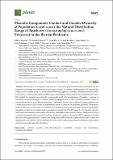Por favor, use este identificador para citar o enlazar a este item:
http://hdl.handle.net/10261/220338COMPARTIR / EXPORTAR:
 SHARE SHARE
 CORE
BASE CORE
BASE
|
|
| Visualizar otros formatos: MARC | Dublin Core | RDF | ORE | MODS | METS | DIDL | DATACITE | |

| Título: | Phenolic Compounds Content and Genetic Diversity at Population Level across the Natural Distribution Range of Bearberry (Arctostaphylos uva-ursi, Ericaceae) in the Iberian Peninsula |
Autor: | Asensio, Esther; Vitales, Daniel CSIC ORCID ; Pérez, I.; Peralba, Laia; Viruel, Juan; Montaner, Celia; Vallès, Joan CSIC ORCID; Garnatje, Teresa CSIC ORCID ; Sales, Ester | Palabras clave: | Arbutin Genetic and phytochemical variability Genome size Haplotypes Natural antioxidants |
Fecha de publicación: | 2020 | Editor: | Multidisciplinary Digital Publishing Institute | Citación: | Plants 9(9): 1250 (2020) | Resumen: | Bearberry (Arctostaphylos uva-ursi) is a medicinal plant traditionally employed for the treatment of urinary tract infections due to high contents of arbutin (hydroquinone β-D-glucoside), which is now mainly used as a natural skin-whitening agent in cosmetics. Bearberry has also been proposed as a natural antioxidant additive due to the high contents of phenolic compounds in leaves. We studied the variation on phenolic compounds in 42 wild populations of bearberry, aiming to elucidate if intrinsic biological, climatic, and/or geographic factors affect phenolic contents across its natural distribution in the Iberian Peninsula. Bearberry leaves were collected during autumn over a three-year period (2014–2016) in populations across a latitude and altitude gradient. Methanolic extracts showed a wide range of variation in total phenols content, and different phenolic profiles regarding arbutin (levels of this major constituent varied from 87 to 232 mg/g dr wt), but also catechin and myricetin contents, which were affected by geographic and climatic factors. Moderate levels of variation on genome size—assessed by flow cytometry—and on two plastid DNA regions were also detected among populations. Genetic and cytogenetic differentiation of populations was weakly but significantly associated to phytochemical diversity. Elite bearberry genotypes with higher antioxidant capacity were subsequently identified. | Descripción: | © 2020 by the authors | Versión del editor: | https://doi.org/10.3390/plants9091250 | URI: | http://hdl.handle.net/10261/220338 | DOI: | 10.3390/plants9091250 | E-ISSN: | 2223-7747 |
| Aparece en las colecciones: | (IBB) Artículos |
Ficheros en este ítem:
| Fichero | Descripción | Tamaño | Formato | |
|---|---|---|---|---|
| Phenolic_Asensio_Art2020.pdf | 2,19 MB | Adobe PDF |  Visualizar/Abrir |
CORE Recommender
PubMed Central
Citations
10
checked on 01-abr-2024
SCOPUSTM
Citations
25
checked on 17-abr-2024
WEB OF SCIENCETM
Citations
21
checked on 27-feb-2024
Page view(s)
371
checked on 18-abr-2024
Download(s)
214
checked on 18-abr-2024

